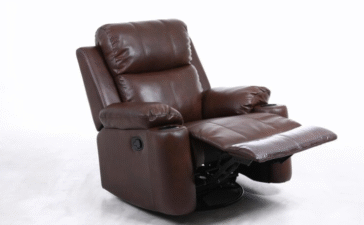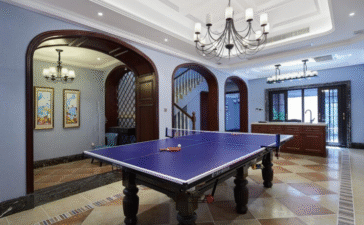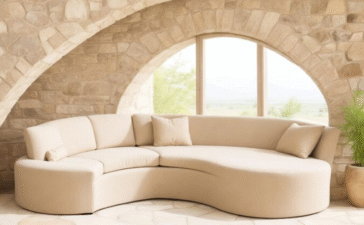A trestle table is more than just a place to eat; it’s a centerpiece that brings people together. With a history stretching back centuries, these tables have a timeless appeal that fits just as well in a rustic farmhouse as it does in a sleek, modern dining room. Their smart design, which replaces traditional legs with supportive trestles, creates an open, inviting space that’s both beautiful and practical.
This guide will walk you through everything you need to know about trestle tables. We’ll cover their unique benefits, explore the variety of styles and materials available, and offer advice on how to choose, build, and care for the perfect table for your home or event. By the end, you’ll understand why this classic design continues to be a favorite for its stability, versatility, and enduring style.
What is a Trestle Table?
A trestle table is defined by its distinctive support system. Instead of four separate legs at the corners, it rests on two or more trestle supports, which are often connected by a long horizontal stretcher beam. These supports, typically shaped like an “A,” “I,” or “X,” distribute the table’s weight evenly, making it incredibly stable.
This design dates back to the Middle Ages, when long, sturdy tables were needed to seat large numbers of people in castles and monasteries. Early versions were simple boards placed on collapsible trestles, designed to be easily stored to make room for other activities. While the construction has evolved to become more permanent and refined, the core principle of a strong, open base remains. This structure not only provides exceptional stability but also offers more legroom, making it a comfortable and popular choice for dining rooms and event spaces alike.
The Benefits of Choosing a Trestle Table
When comparing different types of tables, trestle designs offer several distinct advantages that make them a popular choice.
Unmatched Stability and Space
The primary benefit of a trestle table is its stability. The trestle supports and central beam create a solid foundation that can handle significant weight without wobbling, a common issue with traditional four-legged tables, especially larger ones. This robust structure also maximizes legroom. Since there are no corner legs to get in the way, you can comfortably seat more guests and slide benches underneath for a space-saving seating solution. This makes them ideal for both small dining areas where flexibility is key and large gatherings that require ample seating.
Timeless Design Flexibility
Trestle tables are available in a vast range of styles and materials, allowing them to complement almost any interior design. From rustic farmhouse tables made of reclaimed wood to modern versions featuring sleek metal bases and polished oak tops, the design possibilities are endless. This versatility extends to their use in different settings. A classic wooden trestle table can bring warmth to a dining room, while a durable, collapsible model is perfect for weddings, banquet halls, and corporate events. Their adaptability ensures they remain a stylish and functional choice for any space.
Popular Trestle Table Styles and Materials
The beauty of a trestle table lies in its ability to adapt to different aesthetics through various styles and materials.
Exploring Trestle Table Styles
Different styles of trestle tables can set the tone for your entire space. Rustic trestle tables often feature thick, reclaimed wood with natural imperfections, creating a warm, earthy feel. Farmhouse-style tables are similar but tend to have a more refined, clean finish, often painted white or a soft neutral color. For a more contemporary look, modern trestle tables combine sleek lines, minimalist trestle designs, and materials like metal or polished hardwoods. If you can’t find exactly what you’re looking for, many furniture makers offer bespoke options, allowing you to customize the style, size, and finish to create a truly one-of-a-kind piece.
Choosing the Right Material
The material you choose impacts the table’s durability, maintenance, and overall look. Wooden trestle tables are the most common, with oak being a popular choice for its strength and beautiful grain. Pine offers a more affordable, rustic alternative, while reclaimed wood provides character and a unique history. In modern designs, a metal base is often paired with a wooden top to create an industrial or minimalist aesthetic. When selecting a material, consider its durability and the level of care required. Hardwoods like oak are more resistant to scratches, while a metal base offers excellent stability with minimal maintenance.
Trestle Tables for Every Occasion
The versatility of trestle tables makes them suitable for a wide range of uses, from daily family meals to large-scale special events.
Trestle Tables for Your Dining Room
In a dining room, a trestle table serves as a functional and inviting centerpiece. Its design allows for flexible seating, accommodating both chairs and benches. Standard sizes range from 4ft, perfect for smaller families, to 10ft or more for those who love to host large dinner parties. When choosing a table, consider your room’s decor. A chunky oak trestle table can anchor a traditional space, while a design with a slim profile and clean lines will fit perfectly in a modern home.
Trestle Tables for Events
For weddings, banquets, and corporate events, trestle tables are a practical and stylish choice. Their sturdiness makes them reliable for holding heavy catering equipment and elaborate decorations. Many event-focused trestle tables are designed to be collapsible, which allows for easy transportation and storage. This feature is invaluable for event rental companies and venues that need to adapt their space for different functions. The long, continuous surface of a trestle table also encourages a communal atmosphere, making them ideal for celebratory gatherings.
Outdoor Trestle Tables
Trestle tables can also be used to create beautiful outdoor dining areas on patios or in gardens. For outdoor use, it is crucial to select materials that can withstand the elements. Look for tables made from weather-resistant woods like teak or cedar, or metal bases with a protective powder coating. Applying a weather-resistant finish can also help protect the wood from sun and moisture, ensuring your outdoor table remains a beautiful gathering spot for years to come.
DIY Guide: How to Build a Trestle Table
Building your own trestle table can be a rewarding project that gives you a custom piece of furniture tailored to your exact specifications.
A Step-by-Step Guide
To start, you’ll need a solid plan. Many DIY trestle table plans are available online, detailing the cuts and assembly process. The basic steps involve building the two trestle supports, cutting the tabletop and the central stretcher beam to size, and then assembling the pieces. Essential tools include a saw, a drill, a sander, and measuring tape. For materials, choose a sturdy wood like pine or oak for the base and top.
Tips for Customizing Your Table
The DIY process offers endless opportunities for customization. You can personalize your table by choosing a unique stain or paint color that matches your decor. For a rustic look, you might distress the wood before finishing it. For a more modern feel, consider combining a wooden top with metal trestle supports. When building, one common mistake to avoid is not ensuring all your cuts are precise and your angles are correct, as this can lead to a wobbly table. Double-check all measurements before cutting and assembling.
Trestle Table Maintenance and Care
Proper care will ensure your trestle table remains a beautiful and functional piece for generations.
Daily Care and Cleaning
To preserve your table’s finish, clean it regularly with a soft, damp cloth. Avoid harsh chemical cleaners that can damage the wood. For wooden tables, use coasters and placemats to protect the surface from heat and moisture. Minor scratches on wooden surfaces can often be repaired with a touch-up marker or a wax repair stick that matches the wood’s color.
Refinishing and Restoring
Over time, your table may show signs of wear and tear, and refinishing can restore it to its original beauty. The process typically involves sanding down the old finish, applying a new stain or paint, and sealing it with a protective topcoat like polyurethane. Before you begin, identify the type of wood and choose refinishing products that are appropriate for it. Restoring a trestle table not only revives its appearance but also helps protect the wood for years to come.
A Guide to Buying the Perfect Trestle Table
If a DIY project isn’t for you, there are many excellent options available for purchase.
Where to Buy
Trestle tables can be found at a variety of retailers, from large furniture stores like Pottery Barn and Crate & Barrel to online marketplaces like Etsy, which often feature handmade or custom pieces. For those on a budget, stores like IKEA and Wayfair offer affordable options. If you’re an event planner or need multiple tables, consider looking for wholesale suppliers who offer bulk purchasing discounts.
What to Look for When Buying
When shopping for a trestle table, consider its size, material, and design in relation to your space and needs. Check the quality of the construction, ensuring the joints are secure and the table is stable. It’s also important to understand the retailer’s warranty and return policies. To get the best deal, compare prices from different sellers and look out for seasonal sales or promotions. Reading customer reviews can also provide valuable insight into the quality and durability of a specific table.
Also Check: “pecos table“
Troubleshooting Common Trestle Table Issues
Even the sturdiest trestle tables can sometimes develop issues, but most are easy to fix.
A wobbly table is the most common problem and is often caused by loose joints or an uneven floor. First, check all the screws and bolts connecting the trestle supports to the tabletop and stretcher, and tighten any that are loose. If the floor is uneven, you can place shims or adjustable furniture feet under one of the trestle supports to level the table. If a trestle support becomes damaged, it may be possible to repair it with wood glue and clamps or, if necessary, replace it entirely by contacting the manufacturer or a local woodworker.
Why Trestle Tables Are a Timeless Choice
Trestle tables have remained a popular choice for centuries for good reason. They offer a unique combination of stability, versatility, and timeless style that few other designs can match. Their open structure provides ample legroom and seating flexibility, making them perfect for everything from intimate family dinners to large-scale events.
Whether you prefer a rustic, modern, or farmhouse look, there is a trestle table to suit your taste. The long-term value of a well-made and properly maintained trestle table is undeniable, as it can serve as a gathering place for family and friends for generations. Whether you choose to buy one from a trusted retailer or build your own, a trestle table is an investment in style and functionality that will never go out of fashion.
Frequently Asked Questions
What is the main advantage of a trestle table?
The main advantage is its superior stability and increased legroom. The trestle support system distributes weight evenly and eliminates the corner legs found on traditional tables, allowing you to seat more people comfortably.
Are trestle tables good for small spaces?
Yes, trestle tables can be excellent for small spaces. Because you can slide benches completely underneath them, they can save a significant amount of floor space when not in use. Their open design also creates a less cluttered look.
How many people can you seat at a 6ft trestle table?
A standard 6ft (or 72-inch) trestle table can comfortably seat six people, with three on each side. If you also use the ends of the table, you may be able to accommodate up to eight people.
What is the difference between a trestle table and a refectory table?
The terms are often used interchangeably, but there can be subtle differences. Both have a similar support structure. However, traditional refectory tables are typically very long and narrow, originating from their use in monastery dining halls. Trestle table is a broader term that encompasses a wider variety of styles and sizes.
Can you use a bench with a trestle table?
Absolutely. Benches are a popular seating choice for trestle tables because they can be tucked neatly underneath, and their linear style complements the table’s design.
How do I stop my trestle table from wobbling?
First, check and tighten all screws and bolts. If the table still wobbles, the floor may be uneven. You can use furniture pads or shims under one of the trestles to stabilize it.
What wood is best for a trestle table?
Hardwoods like oak, maple, and walnut are excellent choices due to their durability and beautiful grain. For a more budget-friendly or rustic option, pine is a popular choice, though it is a softer wood and may dent more easily.












